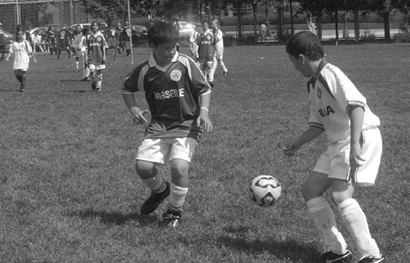By Ronda Kaysen
The Battery Park City ballfields will likely stay open during construction of two new luxury towers, local officials say.
The baseball diamonds could be reconfigured to protect players from flying debris during construction of the residential towers so they won’t need to close for safety reasons.
“It looks like a very good possibility,” James Cavanaugh, president and C.E.O. of the Battery Park City Authority, told Downtown Express. “Our goal is within a couple of weeks to be able to go to the community and say ‘this is the plan.’”
The large fields, which are used by nearly 1,500 players in the Downtown sports leagues, sit on the edge of the West Side Highway between Warren and Murray Sts., opposite P.S./I.S. 89.
In June, Cavanaugh told Community Board 1 chairperson Julie Menin that the heavily used ballfields might close during construction. The news sent ripples of anxiety through the Downtown community, which uses the wide, open space extensively.
After months of discussions with developer Milstein Properties, a deal appears imminent. Milstein is “very interested in working with the community,” said Cavanaugh. “We’ve been very pleased with their attitude so far.”
Cavanaugh said the authority would rearrange the diamonds so they abut West St., away from the construction sites on North End Ave. With the two home plates far away from construction, the outfield could be shortened, if necessary. Construction is likely to begin in the spring and continue for two years. If the situation is not remedied, players could face two years without access to the only ballfields Downtown.
Representatives from C.B. 1 will meet with the developer Friday. Jeff Galloway, a C.B.1 member who has been involved in the negotiations, added that he hopes the Downtown Little and Soccer Leagues will be involved in any design changes to the fields so they meet their needs.
World Trade Center recovery vehicles parked in the ballfields after Sept. 11, 2001. The authority later spent $8 million rebuilding the fields, which were originally considered temporary.
The authority closes the fields in the winter months so it can maintain the grass there. The community board would like to see the grass replaced with artificial turf so the fields can be used year round by the thousands of children and adults who play there. However, the authority prides itself on creating an environmentally friendly neighborhood with green buildings and extensive open space. Replacing a field of grass with synthetic material would fly in the face of the neighborhood policy.
“It would be inconsistent of us to be requiring developers to put in roof gardens and at the same time rip up grass and put in turf,” said Cavanaugh, adding that live grass helps clean the nearby Hudson River, filters rain water, and reduces urban heat. Also, “Natural turf is a better playing surface.”
C.B. 1 members have all but abandoned hopes of swaying the authority, which is controlled by the governor. At a recent C.B. 1 meeting, board members indicated that they hoped the next gubernatorial administration, which takes office next year, might be more sympathetic to their concerns.
“We’re biding our time,” said C.B. 1 Youth Committee chairperson Paul Hovitz at the Sept. 26 meeting. “We support children opposed to grass.”
Ronda@DowntownExpress.com































